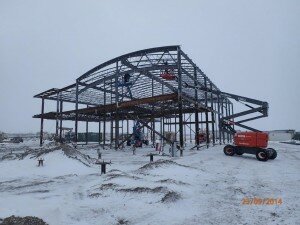
In the fall of 2014, construction of CHARS began, starting with the Field and Maintenance Building and triplexes. Image from http://www.science.gc.ca
The Question
How is the government addressing the impact of high contamination in the Far North on Aboriginal peoples?
The Background
Existing research, including through the federal Northern Contaminants Program, finds that the far north is a hotspot for contamination. The contaminants found there include including persistent organic pollutants (POPs) that show up in human breast milk, in the soil, and in waterways. Additional toxic substances are generated by the extraction industries, such as mining, and oil and gas operations. These are highly concentrated in the marine life that serves as food for traditional Indigenous diets.
The Canadian government recently announced the launch of the Canadian High Arctic Research Station (CHARS) located in Cambridge Bay, Nunavut. It is responsible for advancing Canada’s knowledge of the Arctic and strengthening Canadian leadership in polar science and technology. CHARS is meant to support research on both environmental science and resource development, including resource development by the Mining Association of Canada and the Canadian Association of Petroleum Producers. See below for more information.
Your Letter to the Head of CHARS and Federal MinistersDear Dr. Martin Raillard, Head of CHARS,
We are pleased to hear about the launch of the Canadian High Arctic Research Station (CHARS) and its mission to support research on the environmental monitoring of ongoing resource development in the Far North. This research priority is crucial as environmental problems are likely to increase with further resource development in the Far North. We are happy to see that many of the research projects included in CHARS Science and Technology Plan for 2014 to 2019 focus on environmental monitoring, with the aim to establish a baseline for contamination. However, what is clear is that current contamination levels in the region are well above the baseline elsewhere.
In addition to monitoring, is there a plan for how the Canadian High Arctic Research Station will address the high concentrations of contaminants to which those living in the Far North are disproportionately exposed? How will CHARS’s research priorities address the environmental justice challenges that already exist in the region, including high concentrations of POPs in human and marine ecosystems?
I am writing this email as part of Write2Know (https://write2know.ca) a letter-writing campaign that aims to mobilize public awareness and inquiry into federal research programs. We want to let you know that we value federal science and scientists, and that our questions arise out of genuine concerns about the health and well-being of Canadians.
We remain concerned about the legacy of constraints on access to federal scientists and the results of their research, the elimination of essential research programs, and the closure of libraries and archives. These constraints and closures have impacted what Canadians can and cannot know about the health of their bodies, communities, and environments. We are hopeful that a new government will address our concerns.
We are posing questions to federal scientists about their research and findings, and forwarding our letters to federal Ministers and Members of Parliament to call attention to serious gaps between scientific evidence and government policy.
I look forward to your response.
Sincerely,
cc
Dr. Martin Raillard, Chief Scientist for the Canadian High Arctic Research Station (CHARS)
Hon. Carolyn Bennett, Minister of Indigenous and Northern Affairs
Hon. Jane Philpott, Minister of Health
Hon. Jim Carr, Minister of Natural Resources
Hon. Hunter Tootoo, Minister of Fisheries, Oceans and the Canadian Coast Guard
Disclaimer: Any emails you send to a government email address potentially remain on file. Any contact information you provide, including your name, email address, IP address, and geographic location may be kept and used by the government institution you contact.
Please enter your information in the fields below to send your letter. Click on “Read the Petition” if you would like to edit the letter before you send it.
[emailpetition id=”3″] [signaturelist id=”3″]More Information
The Science and Technology Plan for 2014 to 2019 for CHARS
